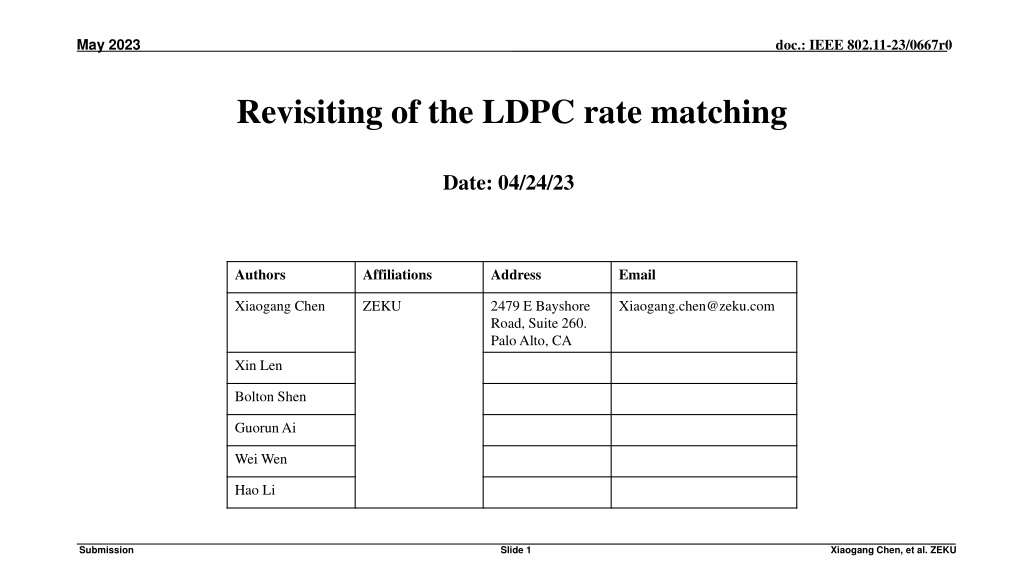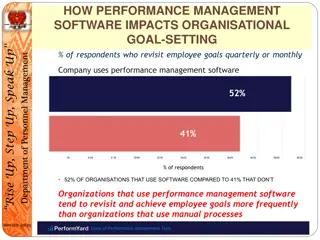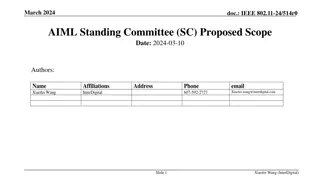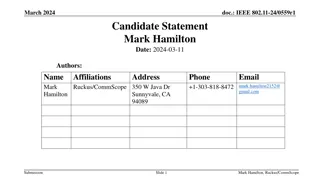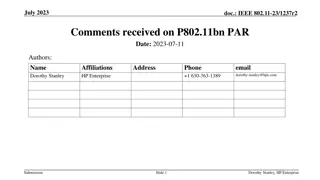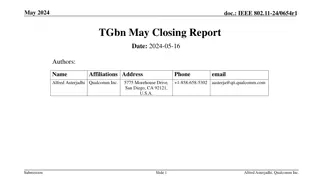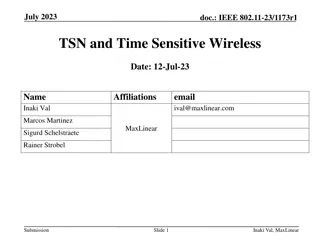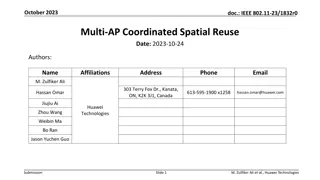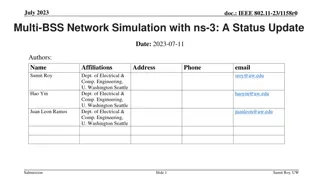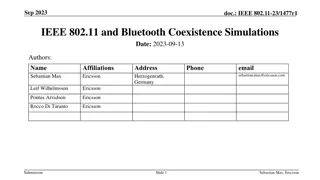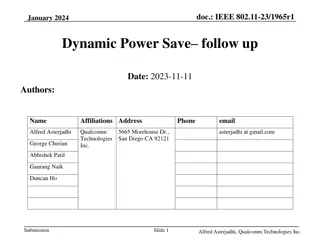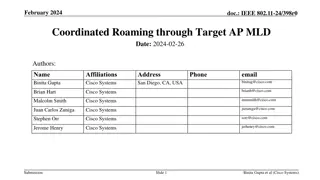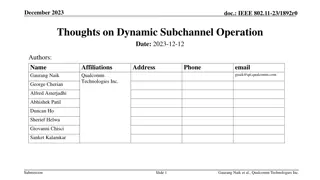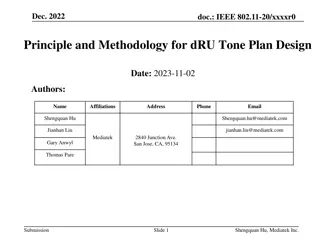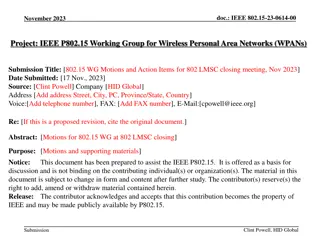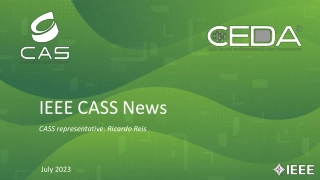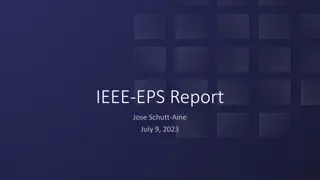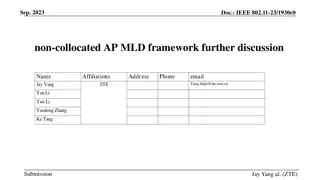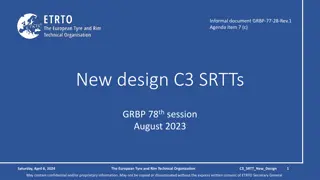Revisiting LDPC Rate Matching in IEEE 802.11 for Improved Performance
The document discusses revisiting LDPC rate matching in IEEE 802.11, focusing on issues such as performance loss compared to previous standards, power consumption in LDPC decoding/encoding, and over puncturing. It covers preliminary concepts, packet size distribution in various devices like laptops and smartphones, scheduling behaviors, and padding techniques used in different IEEE standards. The analysis includes data on packet lengths, packet size distribution, and scheduling behaviors for improved transmission efficiency and performance.
Download Presentation
Please find below an Image/Link to download the presentation.
The content on the website is provided AS IS for your information and personal use only. It may not be sold, licensed, or shared on other websites without obtaining consent from the author. Download presentation by click this link. If you encounter any issues during the download, it is possible that the publisher has removed the file from their server.
Presentation Transcript
May 2023 doc.: IEEE 802.11-23/0667r0 Revisiting of the LDPC rate matching Date: 04/24/23 Authors Affiliations Address Email Xiaogang Chen ZEKU 2479 E Bayshore Road, Suite 260. Palo Alto, CA Xiaogang.chen@zeku.com Xin Len Bolton Shen GuorunAi Wei Wen Hao Li Submission Slide 1 Xiaogang Chen, et al. ZEKU
May 2023 doc.: IEEE 802.11-23/0667r0 Outline Preliminaries Distribution of the packet size in the field; Scheduler of the transmitter; Background of PHY/MAC padding. Three issues on the LDPC rate matching: Performance loss of 11ac/ax/be vs 11n; Higher power consumptions in LDPC decoding/encoding; Over puncturing. Submission Slide 2 Xiaogang Chen, et al. ZEKU
May 2023 doc.: IEEE 802.11-23/0667r0 Preliminaries - distribution of the packet size in the field Laptop for daily use: email, documents, remote desktop, etc. Topic / Item Average Min Val Packet Lengths 280.72 40-79 - - 80-159 154 160-319 204.57 320-639 424.35 640-1279 1119.83 1280-2559 1591.25 >=2560 - - Laptop Webex Average 330.6 - 154 250.42 405.22 1108.72 1448.25 - Max Val Percent Topic / Item Packet Lengths 40-79 80-159 160-319 320-639 640-1279 1280-2559 >=2560 Min Val Max Val Percent 154 2042 100% 0.00% 0.04% 88.89% 4.69% 4.81% 1.57% 0.00% 154 1969 100% 0.00% 0.01% 57.07% 41.37% 0.72% 0.83% 0.00% - - - 154 160 320 641 1284 154 319 638 1274 2042 154 160 320 640 1280 154 318 632 1279 1969 - - - Smart Phone: Everything except 4K video streaming Topic / Item Average Min Val Packet Lengths 506.28 80-159 - - 160-319 214.45 320-639 433.04 640-1279 929.73 1280-2559 1530.46 >=2560 - - Smart Phone: 4K Video streaming Topic /ItemAverage Min Val Packet Lengths 1339.18 80-159 - - 160-319 201.56 320-639 430.95 640-1279 872.41 1280-2559 1407.11 >=2560 - - Max Val Percent Max Val Percent 164 2042 100% 0.00% 4.14% 1.13% 1.31% 93.42% 0.00% 164 2044 100% 0.00% 59.37% 17.98% 7.60% 15.06% 0.00% - - 164 322 645 1283 319 636 1263 2042 164 320 641 1280 319 638 1279 2044 - - Although the max PSDU size is >15MByte in theory, the PPDU size is usually small for many applications. All PPDU in statistics are Qos Data coded by LDPC in 11ax PPDU. Every statistics are conducted based on capturing ~1 million QoS packet from different vendors. Chance of aggregation is low for smaller packet and high for larger packet. Submission Slide 3 Xiaogang Chen, et al. ZEKU
May 2023 doc.: IEEE 802.11-23/0667r0 Preliminaries AP s scheduling behavior Even for small packet size, transmitter always try to use highest rate, if possible, to transmit. Highest rate means: Largest BW; Highest MCS; Highest nSS. PSDU size is usually not a factor for rate selection. Rate is usually selected in advance; MPDU size is not quite predictable. Submission Slide 4 Xiaogang Chen, et al. ZEKU
May 2023 doc.: IEEE 802.11-23/0667r0 Preliminaries - pre-FEC padding/post-EOF padding 11n repeats systematic & parity bits (after encoding) to fill the OFDM symbol boundary; Repeated bits after FEC coding will improve performance if proper LLR combination is conducted at the receiver. 11ac/ax/be use pre-FEC bits to fill the OFDM boundary. Pre-FEC bits are dummy information that is transparent to PHY and waste resources. 11ac indicates the pre-EOF payload in VHT-SIGB already (signaling overhead paid) but still use pre-FEC padding (doubles overhead). 11n scheme LDPC CW1 LDPC CW1 PSDU Repeat Add A-MPDU EOF padding Repeated Bits 11ac/ax/be scheme Symbol LDPC CW1 LDPC CW1 PSDU Puncture Pre-FEC Padding LDPC CW2 LDPC CW2 Symbol Submission Slide 5 Xiaogang Chen, et al. ZEKU
May 2023 doc.: IEEE 802.11-23/0667r0 Performance degradation (the 1stissue) Effective coding rate (eCR) dominate the sensitivity. eCR = nPld / (nPld + nParity - nPunc + nRep); In many cases, 11n has lower eCR. 11ac may have lower eCR in other cases by paying extra symbol; The left figure is not a fair comparison for 11n when 11ac has a lower eCR, it uses more symbol. The curve of light blue uses 11n scheme (without pre-FEC padding) but with the 11ac overhead (nSym) for the same PSDU size Guaranteed lower coding rate if 11n scheme is used! Note: the PSDU(Bytes) is counted for 11n as fair comparison. 11ac will add dummy bits as pre-FEC. The true PSDU will be larger due to the dummy padding. Submission Slide 6 Xiaogang Chen, et al. ZEKU
May 2023 doc.: IEEE 802.11-23/0667r0 How the effective coding rate affects sensitivity? Sims assumptions: ChD NLoS. 1x1x1 (left), 4x2x1(right), BW 40MHz, MCS4/7. Sensitivity is simulated between 11ac and 11n. Similar gaps are observed for other MCS/BW/Pld combinations. Gap (dB) ChDNLoS Gap (dB) ChDNLoS Sensitivity(dB@10% PER) Sensitivity(dB@10% PER) MCS 4 4 4 nBytes 201 323 11n 11ac 11n-11ac -2.22 -1.33 -0.42 -0.53 -0.42 -4.07 -2.13 -1.21 -0.94 -0.52 MCS 4 4 4 nBytes 201 323 11n 11ac 11n-11ac -2.03 -1.02 -0.19 -0.5 -0.43 -4.07 -1.84 -1.5 -0.64 -0.27 15.00 17.22 13.309 15.337 16.19 17.52 14.339 15.360 687 16.99 17.40 687 15.213 15.400 4 849 17.06 17.58 4 849 15.170 15.670 4 1011 17.13 17.54 4 1011 15.253 15.685 7 201 21.17 25.24 7 201 18.933 23.006 7 336 23.23 25.36 7 336 21.195 23.038 7 539 23.99 25.20 7 539 21.719 23.218 7 741 24.3 25.26 7 741 22.516 23.152 7 944 24.8 25.28 7 944 22.887 23.158 Submission Slide 7 Xiaogang Chen, et al. ZEKU
May 2023 doc.: IEEE 802.11-23/0667r0 Performance gap of 11be vs. 11n scheme Similar gap is observed. Note: 11n scheme means pre-FEC padding is not added (Pld size is indicated) and everything else is the same as 11ax/be. Submission Slide 8 Xiaogang Chen, et al. ZEKU
May 2023 doc.: IEEE 802.11-23/0667r0 Power consumption (the 2ndissue) nCW per symbol impacts the scheduling of the LDPC decoder ( also encoder) cores Input to the scheduler: data rate (nCW/Symbol), timing of turn around, etc; Output of the schedule: n_Iterations (performance), n_Decoders to power on / clock (power consumption), etc. Fewer codewords per symbol means more iterations can be scheduled for each codeword; Less decoders can be powered on; Lower clock can be used. nCW in the last symbol can also impacts the trade off between decoding performance and timing. nIteration may be reduced to meet the timing. Submission Slide 9 Xiaogang Chen, et al. ZEKU
May 2023 doc.: IEEE 802.11-23/0667r0 nCW per symbol for high data rate (1/2) The difference of nCW/Symbol could be significant: 2 vs. 11 or 13; 2 vs. 6 or 7 Dummy padding adds extra dummy codewords for PHY. E.g.: With 11n scheme receiver needs to decode 2 CWs but needs to decode 13 CWs in 11be So does the power consumption. This is true for most of the payload size (not only for small payloads). Slide 10 Submission Xiaogang Chen, et al. ZEKU
May 2023 doc.: IEEE 802.11-23/0667r0 nCW per symbol for high data rate (2/2) Submission Slide 11 Xiaogang Chen, et al. ZEKU
May 2023 doc.: IEEE 802.11-23/0667r0 Cases even more illogical There are even illogical cases that has: Higher eCR -> worse performance; More symbols in a PPDU -> more air-time; More nCW/Symbol -> higher power consumption. Submission Slide 12 Xiaogang Chen, et al. ZEKU
May 2023 doc.: IEEE 802.11-23/0667r0 More information 11be has 3x more dummy bits padded comparing with 11ac even with the introduction of a factor. If larger BW is introduced in 11bn and the current rate matching scheme is still in service, 4x, 5x more dummy bits padding can be expected... Slide 13 The gap of eCR ( 11n scheme vs. 11be scheme) will increase if a packet is transmitted with: A larger nDBPS -> Large BW, higher MCS/nSS (generally be used in an area with good coverage). A smaller Payload size -> most applications in daily usage. Submission Xiaogang Chen, et al. ZEKU
May 2023 doc.: IEEE 802.11-23/0667r0 Over-Puncturing (the 3rdissue) The criteria below are used to avoid over-puncturing in LDPC. 30% puncturing is set as one criteria; 10% puncturing is set as another criteria together with a threshold of nbits_short. Extra symbol (n_SD_short) is added only once if either criteria is TRUE . New RU size and MCS introduced in 11be are leaving this mechanism more broken. Submission Slide 14 Xiaogang Chen, et al. ZEKU
May 2023 doc.: IEEE 802.11-23/0667r0 Over-Puncturing the reason The number of data tone in one extra symbol (N_SD) for 11n/ac is 52/108/234/468 for BW of 20/40/80/160MHz respectively. The number of data tone with one extra quarter symbol (N_SD_Short) for 11be could be much less than 11n/ac especially with the MCS 14/15. Since extra symbol is only applied one time, the number of cases of over- puncturing in 11be could be significantly higher than 11n/ac. (5000 cases 11be vs 50 cases 11n/ac) All the combinations violating the rule of over-puncturing are included in the excel attached. Note that: Over-puncturing impacts the modes of low-rate (<20Mbps) Smaller RU size; Lower MCS. For those cases, one extra symbol has already been applied. Unreasonable small packet size has been removed from the list Submission Slide 15 Xiaogang Chen, et al. ZEKU
May 2023 doc.: IEEE 802.11-23/0667r0 Over-Puncturing the impacts In short, the impacts are not quite simple to evaluate without extensive simulations Puncturing itself may introduce 0.5~2dB loss depends on puncturing ratio (10%-30%) Blk: 0% Punc; Red: 10% Punc; Blue: 20% Punc; Green: 30% Punc. Note: sims is for 1 CW (1944) in ChDNLoS 4x2x1. Shortening may offset the performance loss due to puncturing. One example of 20MHz MCS0 1ss Pld 361B has punc ratio~23%. Pld 360B has punc ratio~2%. Sensitivity loss is ~0.4dB with over-puncturing and shortening. Submission Slide 16 Xiaogang Chen, et al. ZEKU
May 2023 doc.: IEEE 802.11-23/0667r0 Solutions & Summary 11n scheme needs 20-ish bits to indicate the PSDU size For SU transmission, 20-ish bits needs only one extra 1x-symbol (4us); For MU transmission, e.g. 80Mhz PPDU addressing to 4STAs, only two extra 1x-symbols are required (8us). Overhead may be a concern only if a large number of STAs are scheduled in one PPDU. Well worth the extra signaling overhead considering the gain from performance and power consumptions. The overhead increase due to 11be scheme (pre-FEC padding) could be one extra 4x-symbol due to the 16us PE. Other rate matching scheme can also be developed if similar goal as 11n can be achieved. 5GNR uses similar rate matching in LDPC but has 90+ candidates of payload size to avoid over padding. Regarding over-puncturing, suggest to respect the existing rule and patch the bug (preferred); or redo the evaluation and define new criteria. Bottom line: Considering the new RU/MRU size and MCS introduced, the current LDPC rate matching (still reusing the one developed in 11n) needs a refresh. Submission Slide 17 Xiaogang Chen, et al. ZEKU
